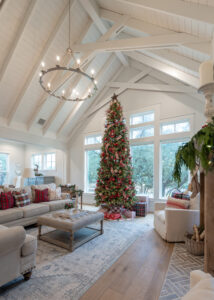
Simple Ways to Make Your 8′ Ceilings Look Higher
In the world of modern home design, soaring ceilings are a coveted feature. But if you’re working with standard 8-foot ceilings, don’t worry, you don’t have to tear out walls or raise the roof to achieve a spacious, airy feel. With smart design choices, you can make low ceilings look higher, helping your home feel larger, brighter, and more sophisticated.
Here’s our go-to tips for designing with 8-foot ceilings and maximizing your space from the ground up using vertical trim work, paint techniques, smart furniture selection, and a few underused architectural details. We recently remodeled a family member’s home that has 8’ ceilings, and we used many of these ideas on that project.

1. Use Vertical Lines to Draw the Eye Up
The most powerful trick in the book? Vertical lines.
Designers have long used vertical elements to create the illusion of height. Whether you’re going for classic, cottage, modern, or transitional style, vertical trim adds character while subtly elongating the room.
Some great vertical trim options include:
- Vertical shiplap – Clean, classic, and beautiful in any room.
- Board and batten – Adds structure and charm while elongating the walls.
- Beadboard – Great for cottage-style homes and cozy spaces.
- Applied vertical molding – A subtle way to add height with a minimal, modern touch.
In this post, we used wallpaper that looks like board and batten and applied it with the lines going up and down to give an illusion of added height in this space.
Below are two examples of vertical wall treatments that we’ve used.

2. Pinch Pleated Curtains (And Hang Them High!)
Curtains play a surprisingly important role in how tall your ceilings feel.
Here’s the trick: mount your curtain rod several inches above the window frame—ideally just 2–3 inches below the ceiling or crown molding. Then let the fabric fall all the way to the floor. This long vertical drop elongates the wall and makes windows feel larger.
For an extra refined look, opt for pinch pleated curtains. Their structured drape and tailored finish naturally direct the eye upward, enhancing the illusion of height. Those pleats and folds are all vertical lines!
Avoid: Short curtains, grommet tops, or café-length panels, which chop the room’s vertical space and emphasize low ceilings.
3. Use Bright White, Reflective Paint
One of the easiest ways to make a room feel taller? Paint.
For low ceilings, you want to keep things light, bright, and reflective. Choose a clean, crisp white for both the walls and ceiling. A consistent color helps blur the boundary between wall and ceiling, making it difficult to tell where one ends and the other begins.
Tips for using paint to your advantage:
- Choose a flat or matte finish for the ceiling to minimize shadows from texture.
- Use satin or eggshell on the walls for a subtle sheen that reflects light.
- Avoid contrast between ceiling and wall colors, which can visually “chop” the room.
Bonus tip: If you’re willing to go the extra mile, remove any popcorn or heavy ceiling texture. A flat, smooth ceiling surface helps the ceiling visually “disappear,” making the room feel more expansive.
4. Embrace Lower or Shorter Furniture
In rooms with standard-height ceilings, bulky or tall furniture can quickly overwhelm the space.
Instead, opt for:
- Low-profile sofas and chairs
- Coffee tables and beds with a lower base height
- Open shelving instead of tall bookcases
- Slim-legged furniture that doesn’t add visual bulk.
For example, you can opt for a standard height dining table instead of a bar height table.
Standard height table:
Bar height table:
By keeping your furniture “grounded,” you increase the visual gap between furniture tops and ceiling lines, helping your room feel more open and less cramped.
5. Keep the Space Bright and Airy
Natural light is your best friend when it comes to elevating the feel of a space. Keep window treatments sheer or minimal, and choose light-colored furniture and rugs to reflect as much light as possible.
Here’s how to keep things feeling fresh:
- Stick with whites, soft neutrals, and pale tones
- Use mirrors to bounce light and expand the room visually
- Avoid heavy, moody color palettes that can make an 8-foot ceiling feel like it’s closing in
While there’s nothing wrong with a cozy, moody space, small rooms with low ceilings benefit most from an airy, light-filled approach.
6. Try a Cove Detail for Seamless Ceiling Transitions
This one’s a throwback, and rarely done these days, but it’s a beautiful architectural detail that can significantly soften the appearance of a low ceiling: a plaster cove.
A plaster cove is a gently curved transition between the wall and ceiling that removes the hard 90-degree angle and creates a more seamless flow. Because you can’t see where the wall stops and the ceiling begins, your eye doesn’t register the ceiling height as clearly- giving the room a lighter, loftier feel.
*It can be a challenge to find proficient plasterers these days, so an alternative is to use a cove-shaped wood trim. The key here is to paint the walls, trim and ceiling the same bright color.
If you’re designing a new home or doing a remodel, this detail is well worth considering. It’s subtle, timeless, and adds a level of craftsmanship rarely seen in modern home designs.
7. Avoid Ceiling Fixtures That Hang Too Low
Lighting can either enhance or hinder your ceiling height illusion.
For 8-foot ceilings, avoid oversized chandeliers, pendant lights, or ceiling fans that hang more than 12–18 inches down from the ceiling. Instead, opt for:
- Flush mount or semi-flush mount fixtures
- Recessed lighting for a clean, unobtrusive look
- Wall sconces to provide vertical illumination without cluttering the ceiling
If you do want a pendant light, like over a kitchen island, make sure it’s scaled appropriately and hung high enough to maintain headroom and openness.
You Can Absolutely Make 8′ Ceilings Feel Higher
Don’t let standard ceiling height limit your design ambitions. With the right visual strategies, including vertical trim, cohesive white paint, low profile furniture, and thoughtful lighting, you can make any space feel taller, brighter, and more elegant.
And remember, it’s not just about tricking the eye. It’s about creating a harmonious, livable space that makes you feel good every time you walk in.
Need help reimagining your home’s architecture and finishes? Our design team specializes in custom solutions that maximize beauty and function—even in homes with 8-foot ceilings.
Click here to download your printable checklist on how to make your 8’ ceilings look taller. Schedule a design consultation with us today!
